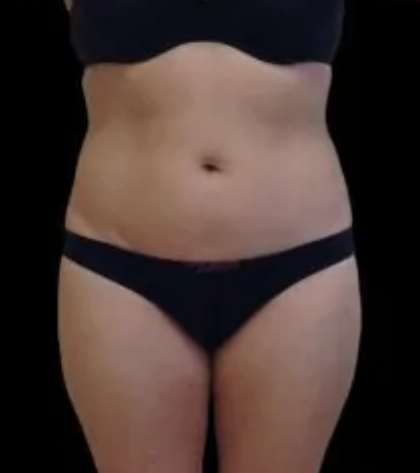What to do about the unsightly disfigured C-Section scar or hysterectomy scar that results in a depression or a dent along the scar? Is there any way to remove it permanently and get your skin back to its former glory?
There are surgical and non-surgical aesthetic solutions that can help you recover that healthy skin. But before we get to that, you have to know first the kinds of scars that require treatment to completely disappear.
Where Can You Get Surgical Scars?
During a C-section, the doctor can make two incisions: a horizontal, low-transverse incision, also called a “bikini cut”, or a vertical incision, more popularly known as the classical C-section.
After the surgery, your doctor may use staples, stitches, glues, or a combination of the three to close the incision. Oftentimes, the wound will heal properly within weeks and leave little scarring on your skin.
The scar can be horizontal, just above the mons pubis after a Pfannensteil skin incision is made.

The skin incision can also be a midline incision (vertical incision) that starts at the belly button and ends right above the mons pubis.

C-section scars are all about giving birth. But there’s another operation that can also give you a permanent scar, and that is by undergoing a hysterectomy.
Hysterectomy is the operation for removing the uterus. Aside from avoiding pregnancy, the operation may be done for a number of reasons including cancer, endometriosis, chronic pelvic pain, and uterine prolapse, to name a few.
Hysterectomies can be performed through various methods: one is through the vagina, another is through the abdomen, and the last is with the help of laparoscopy. The procedure needed to be done will depend on your medical situation and the objective of the surgery.
Of the three operation types, the abdominal hysterectomy is the procedure that will leave ugly and obvious surgical scars in your lower abdomen. Much like C-section scars, they will heal in time.
Here’s where the problem lies: C-section scars and hysterectomy scars will be there, and they may take years before they fade on their own. They’ll still leave marks, but they’ll be less visible by then. But when worse comes to worst, the healing process can go sideways and create keloids or hypertrophic scars.
Living with Ugly Surgical Scars
According to our patients who seek out our minimally invasive solutions, these unsightly, disfiguring and embarrassing scars inhibit them from getting nude. The hideous scars also restrict their ability to wear certain swimwear, activewear, and other more revealing outfits. The popular opinion among women is that they “always hated the scar”.
To understand the magnitude of the aesthetic “disfigurement” from these surgical incisions, research about the C-section procedure was conducted by experts.
According to the CDC, the number of deliveries in the United States was 2,621,010. Of this figure, the number of cesarean deliveries was 1,232,339. The figure can be interpreted that 1 in 3 births in the US happens by C-Section (32% of all deliveries).
Approximately 600,000 hysterectomies are performed annually in the United States and approximately 20 million American women have had a hysterectomy, according to the CDC.
There are five main types of hysterectomies: vaginal hysterectomy, laparoscopic-assisted vaginal hysterectomy, abdominal hysterectomy, laparoscopic-assisted abdominal hysterectomy, and robotic-assisted laparoscopic hysterectomy. Abdominal hysterectomy remains the most common approach for removing the uterus and other reproductive organs.
When performing an abdominal hysterectomy, the surgeon can either use a vertical incision or a bikini cut incision depending on the scope of the surgery.
A complication of these incisions for C-Sections or abdominal hysterectomies is the development of raised scars known as hypertrophic or keloid scars.
Note that these are two distinctly different scars in their behavior and appearance. These scars can be in combination with the depressed scars or they can occur alone.

Keloids caused by surgical scars tend to grow larger even after the original incision has healed. They may spread beyond the cut area until they reach a certain size. Their color varies and may be firm or rubbery in texture.
Keloids can grow for weeks, months, or years; there’s really no telling when, but they’ll eventually stop from getting larger. They’re harmless, though, so there’s no need to worry that they may cause cancer.
Regardless of the feel, texture, or color of the keloids, they are guaranteed to look unattractive. And the biggest thing about them is that they don’t disappear on their own. They have to be removed or treated for the skin to recover.

Hypertrophic scars result from burns, piercings, or cuts. This surgical scar looks like a keloid but with a milder color and texture. It also doesn’t grow beyond the size of the injury.
The scar isn’t dangerous, but it can be itchy and irritating. Of course, like a keloid, it’s unpleasant to look at.
Lucky for you, there are several ways to either minimize the scar’s appearance or completely remove them through special treatments.
Treating Scars
Dr. Matlock offers a minimally invasive procedure for treating surgical scars. The aesthetic solution can be performed through an incision no longer than this line —.
The treatment will permanently release the depressed scar, producing a normal aesthetic appearance that restores depressed transverse or midline scars, so that you can be you. You can choose to have the procedure under local, local with IV sedation, or twilight.
The following video demonstrates what we can do on your lunchtime visit. Yes, you read that correctly. The procedure is that fast
Whether the hypertrophic or keloid scars occur with depressed scars or by themselves, we can treat them by injecting a medication that will flatten them. This can be done in the office with local anesthesia in just about 5 to 10 minutes.
Our scar treatments are extremely effective in solving your aesthetic problems. We may have you combine the treatment with silicone patches or ointment, and massages in your post-operative healing phase to further improve the overall look of your skin.
A detailed explanation of the different types of raised scars is beyond the scope of this blog. It would be our pleasure to discuss further details via consultation (in office, FaceTime, Skype or telephone).
For more information and questions about these common surgical scar problems, reach out to Dr. Matlock.






